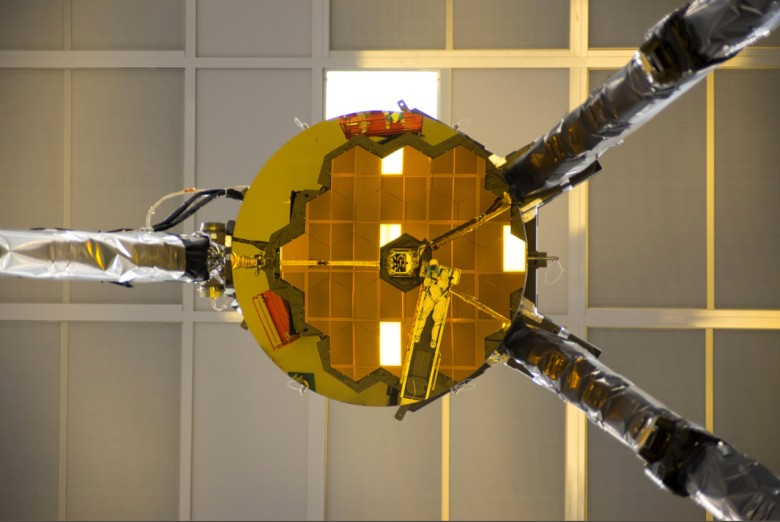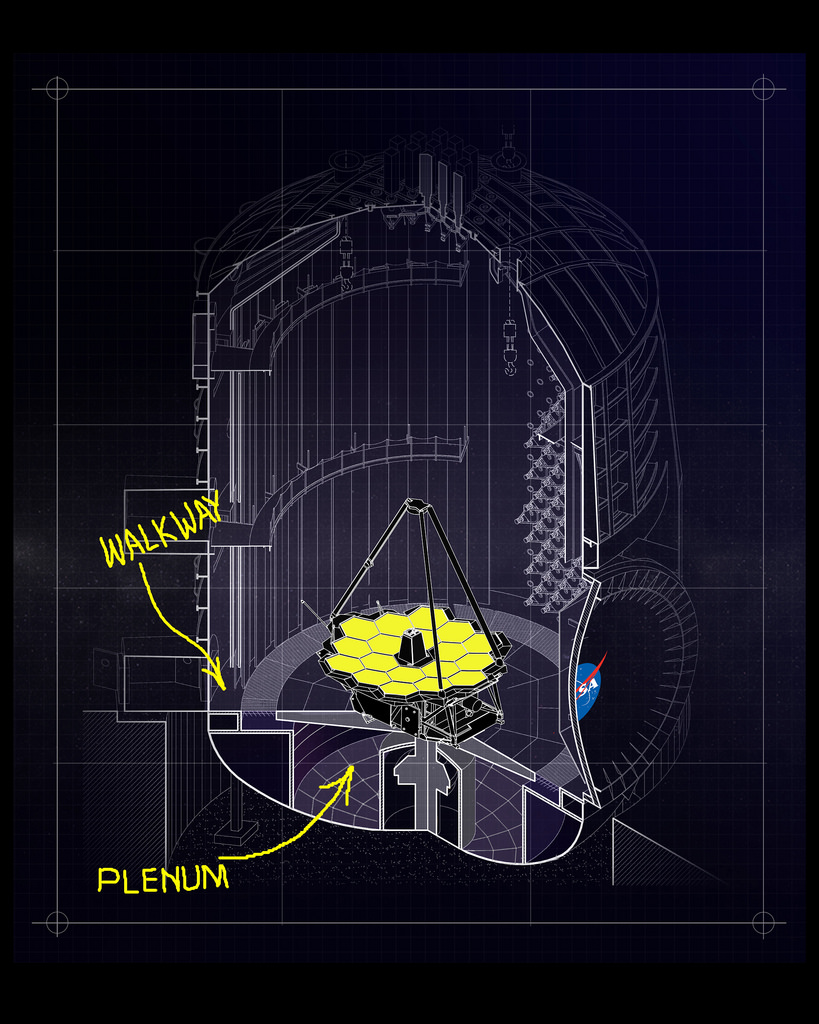Telescope "James Webb" passed a critical test - he took a selfie

An optical engineer of Ball Aerospace Larkin Carey (Larkin Carey) in the supine position is reflected in the secondary mirror of the telescope. James Webb during the shooting of the sighting axis of the equipment, which is involved in the most important test of the telescope optics
In March 2016, NASA engineers successfully completed the installation of the secondary mirror on the James Webb telescope. The main telescope mirror - the collecting surface of a concave parabolic shape - consists of 18 fragments that reflect light onto a secondary mirror of a convex hyperbolic shape. In turn, the secondary mirror directs the collected light through the center of the primary mirror to scientific instruments behind it.
For accurate focusing fasteners main mirror can not be displaced by more than 38 nanometers. This is a very accurate system in which all fixtures must be perfectly aligned. After mounting the secondary mirror, the telescope has been tested in a cryogenic chamber for more than a year, where they check the reliability and proper operation of all its systems in conditions close to real (simulated space). In October 2017, the time has come for the most important test of the entire optical system of the telescope: the primary, secondary and tertiary mirrors in conjunction with scientific equipment.
The optical system of James Webb is schematically depicted in the animation below. It shows that the light collected by the secondary mirror passes through the center of the main mirror onto scientific instruments. The Aft Optics Subsystem (AOS) optical subsystem is installed in the center of the main mirror with a tertiary mirror and a fine-adjustment mirror (fine-steering mirror), which performs optical stabilization and precisely focuses the light on the sensors of scientific equipment. The tertiary mirror also serves to eliminate the optical distortions that are inherent in all optical telescopes.
Auxiliary equipment ASPA (AOS Source Plate Assembly) is installed on top of the AOS optical subsystem, which looks like a black “nose cone” protruding from the center of the main mirror. It is in it that the tertiary mirror and the fine adjustment mirror are located. This mounting hardware is required to preset the AOS optical system, and before launching it into ASP orbit, they will be removed from the telescope.
During testing, the ASPA system played the role of "artificial stars", that is, generated laser pulses at different wavelengths.

In the first part of the test, the ASPA directed the laser directly to the AOS optics, from which light passed through scientific instruments through the tertiary mirror and the fine adjustment mirror. This part of the test tested the performance of the AOS system itself and the interaction of optics with scientific equipment. It is very important that the test confirmed the correct installation of the tertiary mirror, since it is fixed rigidly and motionless, so that its position is not adjustable.
In the second part of the test, the laser beams from the ASPA go a longer way. First, they are sent to the secondary mirror, they are reflected from the main mirror, then they are collected in the secondary mirror and from there they enter the AOS system, following the previous route. This complete test uses all optical systems. He checks not only the alignment of the main mirror, but completely checks the performance of "James Webb" as a single structure. Since the telescope itself generates rays and registers their reflection from all its mirrors itself, such a test can be considered in some sense a self-portrait or, as it is now fashionable to say, a “selfie” or a “self”.
Both tests confirmed that the mirrors are now correctly aligned with each other - and they can also be aligned in space.

Cryogenic test chamber "James Webb"
Before passing the last test engineer-optician company Ball Aerospace Larkin Carey (Larkin Carey) helped rolled into the center of the primary mirror on the sliding board and took a picture of the primary mirror reflection in the secondary. NASA assures that during the procedure all safety protocols for working on the mirror were strictly followed. Everything was completely sterile. On the main mirror of beryllium with a gold film, like no other particle appeared, and the nanometer finishing of the fasteners remained unchanged. The engineer connects the optical cables to the ASPA, lying on a retractable board above the main mirror.

Safety protocols for working on the mirror are necessary, because when ASPA was connected, such work would inevitably have to be carried out: engineers installed and manually connected over the main mirror over 100 optical cables. The engineer connects the optical cables to the ASPA, being placed on a sliding board above the main mirror. At the end of the cryogenic testing, the optics and scientific instruments of the James Webb telescope will be transported to the Northrop Grumman company in California, where it is integrated with the elements of the spacecraft — sun visor and tire. All elements in the collection and become an orbital space observatory them. James Webb. After the final assembly, the entire structure will again be passed through a series of tests and simulations of the launch.

The launch of the James Webb telescope is scheduled for spring 2019. This scientific tool will be the most powerful cosmic observatory: over the next decade it will become a kind of "eyes" of humanity in space.
